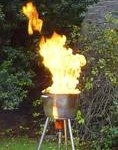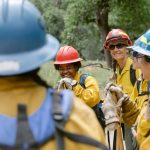 Campfire impacts are among the most common and obvious recreational impacts in wildlands. In backcountry areas of the Northeast, campfires are generally discouraged, and in any of the region’s alpine zones, fires should never be built. Backcountry visitors should always carry the appropriate equipment for warmth, shelter and light, and a lightweight campstove for all cooking needs.
Campfire impacts are among the most common and obvious recreational impacts in wildlands. In backcountry areas of the Northeast, campfires are generally discouraged, and in any of the region’s alpine zones, fires should never be built. Backcountry visitors should always carry the appropriate equipment for warmth, shelter and light, and a lightweight campstove for all cooking needs.
This recommendation against a once-traditional part of back country camping is due to ecological and aesthetic problems at recreation sites caused by overuse and abuse of fires and wood supplies. Because of these cumulative impacts, some land managers and owners have prohibited the use of campfires. Others allow their use in designated sites, or by permit only.
Situations may arise, however, when a fire must or will be built, such as in an emergency, or in areas where fires are still allowed. The techniques outlined below will help you Leave No Trace if you have a fire.
All backcountry visitors should remember that in the heavily traveled wildlands of the Northeast, a fire should be viewed as a tool to be used only when necessary, and that the decision to construct one should never be made arbitrarily.
Know and follow fire restrictions and always carry a stove.
Fires are often banned in sensitive environments, where high use levels have caused excessive impact, and during dry spells when forest fire danger is high. Wind also presents a danger when a fire is burning. Wherever signs of overuse of fires are present, such as the forest floor barren of downed wood, or branches broken off of standing or downed trees, fires should not be built. Proper planning includes carrying a stove for cooking and carrying a flashlight or candle lantern for light.
Make your fire small and safe.
If you build a fire, do so with a conscious commitment to do it in a way that will leave no lasting impact on the environment.
Campfires should only be built if there is abundant dead and downed wood gathered from the ground away from camp. Take the time to walk a few minutes away from camp, then gather wood a few pieces at a time from a large area. Use small-diameter wood no larger than an adult’s wrist as this burns completely, making clean-up easy. Never break branches or strip bark off of any trees, live or dead. Doing this leaves stubs, scars and branch less trees that take away from the feeling of wildness many people seek.
Care and feeding of your fire.
Once the fire’s burning, break firewood into useable lengths as needed. Always attend your fire and keep proper tools, such as a trowel and water, at hand.
Select a durable fire site. The heat and flames from fire cause impact, but so does the concentrated trampling of people cooking or socializing around one.
Fires should be burned down to ash or very small coals, as this helps minimize the impacts of the fire. All fires should be dead out and cleaned up before leaving camp. Remove any litter, and if there is any unused wood, scatter it in the forest. If a fire ring is full of ashes, consider scattering the cold ashes away from camp over a wide area of vegetated ground. They will mix into the soil of the forest floor and mimic the remains of natural forest fires.



